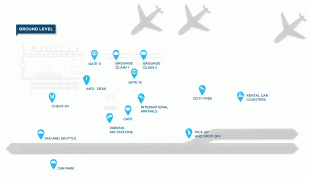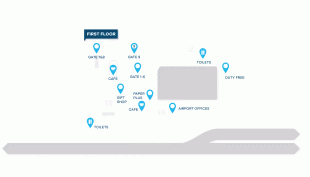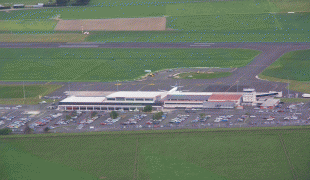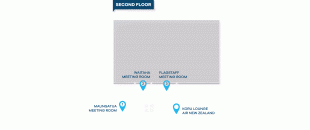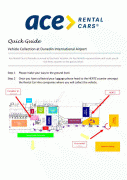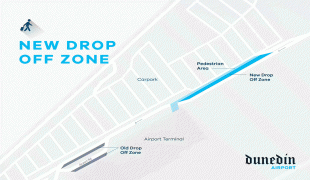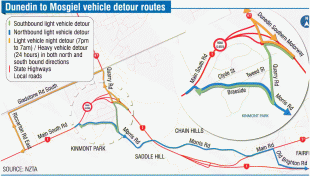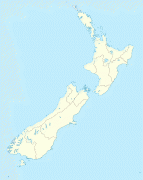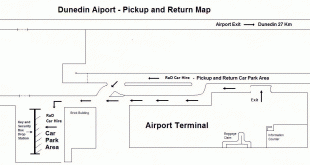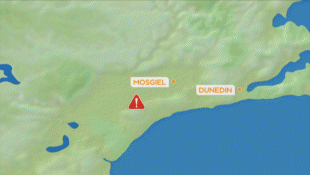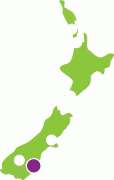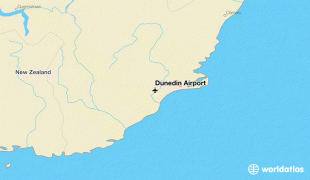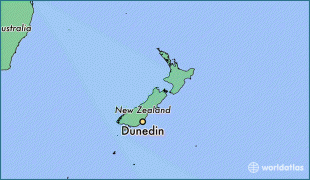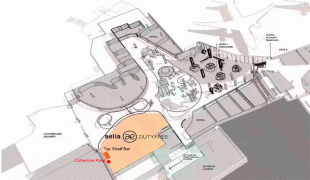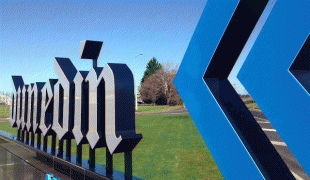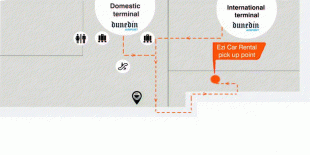Dunedin International Airport (Dunedin Airport)
Dunedin Airport, officially Dunedin International Airport, also known as Momona Airport, is an international airport in the Otago region of the South Island of New Zealand, serving Dunedin city and the Otago and Southland regions. Dunedin Airport is one of two international airports in Otago, the other being Queenstown International Airport. It is located adjacent to the village of Momona on the Taieri Plains approximately 22 kilometres south west of Dunedin CBD. It is the fifth busiest airport in New Zealand by passengers.
It has a single paved runway rated for aircraft up to the Boeing 767, with ILS in both directions. It has one terminal building with five gates, two with airbridges; and also customs facilities and other amenities. Mainland Air, a flight school and charter service, operates from a hangar next to the terminal building. The Dunedin City Council and the Crown each own 50 percent of Dunedin International Airport Limited, a publicly unlisted company which operates the utility.
The old Taieri airfield was not economic to expand to cater for the growth in air travel expected in the future. Construction of the present airport was completed in 1962, and its primary use was to cater for passengers of short haul aircraft. NZNAC started Fokker Friendship services immediately upon opening with Vickers Viscount services starting in December 1962. A large new hangar was completed in 1963. Mount Cook Airlines operated to Dunedin from March 1966 to July 1991. NAC started Boeing 737 services to Dunedin in December 1968. Automatic sliding doors were provided in the terminal in 1969 with a Rothmans clock being installed in the terminal in 1971 and the toilets being expanded that same year. A new mezzanine floor and aircraft viewing deck were installed in 1974. The airport was the scene of a hostage crisis on 19 December 1979 when two borstal escapees held a police officer in the control tower.
The airport was closed due to flooding from June to July 1980. Ansett New Zealand began Boeing 737 (later replaced by BAe 146 aircraft) in December 1988 with airline lounges and airbridges being added in 1988. Extension of the runway to 1,900 metres was completed in May 1993. The first international flight, a Qantas Boeing 737-300 touched down in Dunedin in July 1994. Kiwi Travel International Airlines started regular transtasman flights in August 1995 followed by Freedom Air in December of the same year. Mount Cook Airlines began ATR-72 services to Dunedin in November 1995. Kiwi Air collapsed in September 1996. Ansett New Zealand became Qantas New Zealand in September 2000 and collapsed in April 2001, leaving Origin Pacific to step in for a time. In about 2005, the check-in space was enlarged and a new international arrival area was added. The present terminal building was opened in October 2005. Freedom Air was absorbed into Air New Zealand at the end of March 2008. Virgin Australia began flying to Dunedin in July 2008, followed by Jetstar in July 2011. This airport is the third busiest and largest in the South Island of New Zealand, after Christchurch International Airport and Queenstown Airport.
Air New Zealand used to fly to Brisbane, Melbourne and Sydney until it divested responsibility to Virgin in 2010. Virgin ceased flights to Melbourne and Sydney in 2014, and has withdrawn from the 4 weekly (VA120/123) Brisbane route since March 2020. At the moment the airport has no international services.
The airport's name was changed from Dunedin International Airport to Dunedin Airport in 2015.
It has a single paved runway rated for aircraft up to the Boeing 767, with ILS in both directions. It has one terminal building with five gates, two with airbridges; and also customs facilities and other amenities. Mainland Air, a flight school and charter service, operates from a hangar next to the terminal building. The Dunedin City Council and the Crown each own 50 percent of Dunedin International Airport Limited, a publicly unlisted company which operates the utility.
The old Taieri airfield was not economic to expand to cater for the growth in air travel expected in the future. Construction of the present airport was completed in 1962, and its primary use was to cater for passengers of short haul aircraft. NZNAC started Fokker Friendship services immediately upon opening with Vickers Viscount services starting in December 1962. A large new hangar was completed in 1963. Mount Cook Airlines operated to Dunedin from March 1966 to July 1991. NAC started Boeing 737 services to Dunedin in December 1968. Automatic sliding doors were provided in the terminal in 1969 with a Rothmans clock being installed in the terminal in 1971 and the toilets being expanded that same year. A new mezzanine floor and aircraft viewing deck were installed in 1974. The airport was the scene of a hostage crisis on 19 December 1979 when two borstal escapees held a police officer in the control tower.
The airport was closed due to flooding from June to July 1980. Ansett New Zealand began Boeing 737 (later replaced by BAe 146 aircraft) in December 1988 with airline lounges and airbridges being added in 1988. Extension of the runway to 1,900 metres was completed in May 1993. The first international flight, a Qantas Boeing 737-300 touched down in Dunedin in July 1994. Kiwi Travel International Airlines started regular transtasman flights in August 1995 followed by Freedom Air in December of the same year. Mount Cook Airlines began ATR-72 services to Dunedin in November 1995. Kiwi Air collapsed in September 1996. Ansett New Zealand became Qantas New Zealand in September 2000 and collapsed in April 2001, leaving Origin Pacific to step in for a time. In about 2005, the check-in space was enlarged and a new international arrival area was added. The present terminal building was opened in October 2005. Freedom Air was absorbed into Air New Zealand at the end of March 2008. Virgin Australia began flying to Dunedin in July 2008, followed by Jetstar in July 2011. This airport is the third busiest and largest in the South Island of New Zealand, after Christchurch International Airport and Queenstown Airport.
Air New Zealand used to fly to Brisbane, Melbourne and Sydney until it divested responsibility to Virgin in 2010. Virgin ceased flights to Melbourne and Sydney in 2014, and has withdrawn from the 4 weekly (VA120/123) Brisbane route since March 2020. At the moment the airport has no international services.
The airport's name was changed from Dunedin International Airport to Dunedin Airport in 2015.
| IATA Code | DUD | ICAO Code | NZDN | FAA Code | |
|---|---|---|---|---|---|
| Telephone | +64 3 486 2879 | Fax | +64 3 486 2813 | ||
| Home page | Hyperlink |
Map - Dunedin International Airport (Dunedin Airport)
Map
Country - New_Zealand
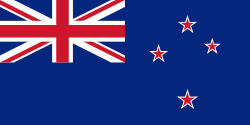 |
 |
| Flag of New Zealand | |
The islands of New Zealand were the last large habitable land to be settled by humans. Between about 1280 and 1350, Polynesians began to settle in the islands and then developed a distinctive Māori culture. In 1642, the Dutch explorer Abel Tasman became the first European to sight and record New Zealand. In 1840, representatives of the United Kingdom and Māori chiefs signed the Treaty of Waitangi, which in its English version declared British sovereignty over the islands. In 1841, New Zealand became a colony within the British Empire. Subsequently, a series of conflicts between the colonial government and Māori tribes resulted in the alienation and confiscation of large amounts of Māori land. New Zealand became a dominion in 1907; it gained full statutory independence in 1947, retaining the monarch as head of state. Today, the majority of New Zealand's population of 5.1 million is of European descent; the indigenous Māori are the largest minority, followed by Asians and Pacific Islanders. Reflecting this, New Zealand's culture is mainly derived from Māori and early British settlers, with recent broadening of culture arising from increased immigration. The official languages are English, Māori, and New Zealand Sign Language, with the local dialect of English being dominant.
Currency / Language
| ISO | Currency | Symbol | Significant figures |
|---|---|---|---|
| NZD | New Zealand dollar | $ | 2 |
| ISO | Language |
|---|---|
| EN | English language |






